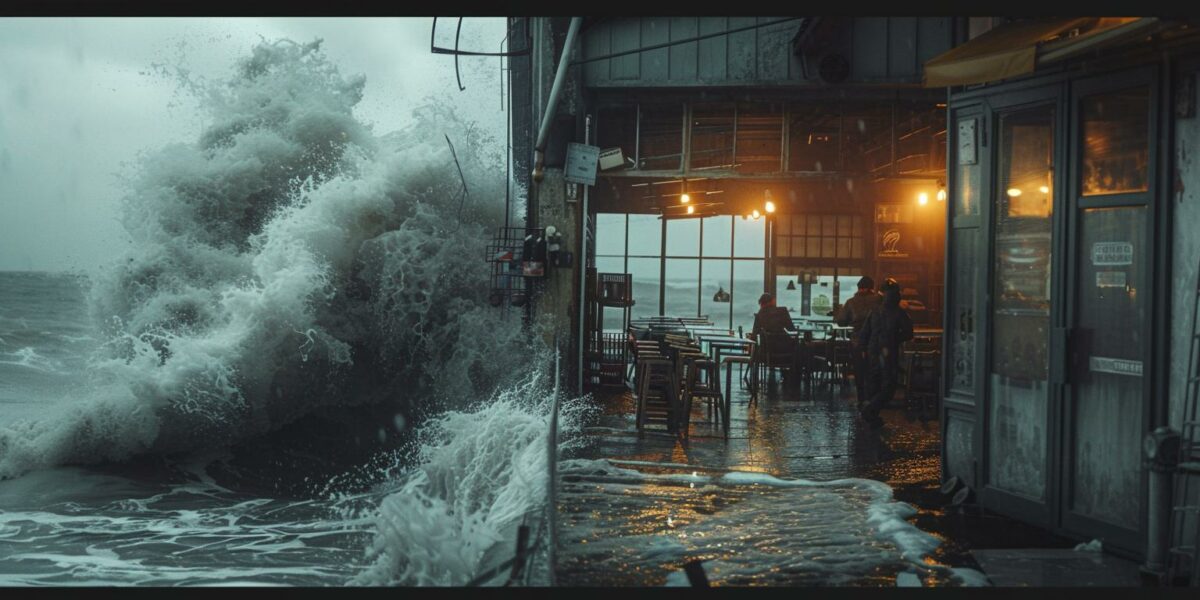Resilient Restaurateurs Facing the Storm
The January storms brought unprecedented challenges for Warren Busteed and Beth Polhemus. Their restaurant, Bred in the Bone, faced severe flooding that damaged crucial equipment. Despite the chaos, their unyielding determination shone through as they rallied to protect their livelihood.
Busteed’s quick thinking during the first storm was critical. With water rising rapidly, he contacted the town and electricians to safely shut off power. This swift action prevented further catastrophic damage to their basement kitchen, showcasing the importance of preparedness.
Polhemus discovered even more damage at their seasonal Contented Sole restaurant. The storm had torn away parts of the building, and the sight of ocean waves inside was surreal. Yet, her belief that everything is fixable kept their spirits high, even as they faced a seemingly indestructible force.
A second storm just days later tested their resolve further. Despite the repeated flooding, the couple’s resolve remained unshaken, a testament to their strength and the supportive community around them.
Climate Change: A Growing Threat
Maine’s iconic seafood restaurants, from lobster shacks to upscale dining spots, face increasing risks from climate change. Rising sea levels and more intense storms threaten their very existence, making the need for adaptive strategies more pressing than ever.
While some proprietors, like those at Harraseeket Lunch & Lobster, consider the risks manageable, others like the owners of Chauncey Creek Lobster Pier are taking proactive measures to safeguard their establishments. These steps include reinforcing structures and moving critical equipment to safer locations.
Even with these precautions, the fast-warming waters in the Gulf of Maine pose additional threats to their menus. Local seafood is a cornerstone of these restaurants, and changes in marine ecosystems could have far-reaching impacts on their offerings.
The resilience of Maine’s restaurateurs is commendable, but the state’s beloved seaside eateries face a future of uncertainty. Their ability to adapt and survive hinges on both their ingenuity and the broader fight against climate change.
Historical Significance and Modern Challenges
For nearly a century, Maine’s coastal restaurants have been a symbol of tradition. Their picturesque locations and mouth-watering menus have drawn visitors from near and far. The advent of the automobile in the 1920s allowed these eateries to flourish, offering convenient dining options for travelers.
However, the same beautiful, vulnerable locations that make these restaurants popular also put them at risk. Owners have always taken steps to protect their establishments, from moving furniture to higher ground to preparing for the worst during storm seasons. These efforts are now more crucial than ever.
John DiSanto of Anjon’s Ristorante exemplifies the resilience needed in this industry. Having faced numerous challenges over the years, including fires and floods, he continues to rebuild and adapt. His story is one of perseverance and hope.
For other restaurateurs, the increasing frequency and intensity of storms are a stark reminder of the changing climate. They must balance the need for immediate repairs with long-term strategies to ensure their survival.
Preparing for an Uncertain Future
In Castine, Dennett’s Wharf is undergoing significant upgrades to withstand future storms. Owner Kip Oberting is investing heavily in climate resilience, from rebuilding decks to raising the building’s foundation. These measures are costly but essential for the restaurant’s future.
Other restaurateurs, like those at Five Islands Lobster Co., adopt a more philosophical approach. Gina Longbottom acknowledges the reality of climate change but focuses on what is within her control. Her resilience is a testament to the spirit of Maine’s coastal community.
Insurance is another critical factor for these businesses. While some, like Bred in the Bone, carry flood insurance, the high costs make it a difficult decision for many. The balance between risk and cost is a constant challenge, especially for those in high-risk areas.
Despite these hurdles, Maine’s coastal restaurateurs remain hopeful. Their unwavering dedication to their craft and community, combined with strategic preparations, offers a glimmer of hope in the face of an uncertain future.



jasperwhisperwind
Insurance costs are insane! How do small businesses even manage to stay afloat?
Trinity
Reading this makes me want to visit Maine even more. Can’t wait to support these resilient places!
whiskey
Great article! But what about the impact on the fishermen supplying these restaurants?
felix
Man, those storms sound brutal! Hope they don’t become a new normal. 😟
amelia
Why isn’t there more focus on sustainable building materials for these coastal spots?
bailey1
You’d think with all the risks, they’d move the restaurants inland. Just saying.
jackson
Kudos to Warren and Beth! It’s amazing how they bounced back after such a tough time. 🙏
charlotte
Does anyone know if there are government grants to help these restaurants recover?
Boots
Wow, these stories are so inspiring! Keep fighting the good fight, Maine restaurateurs! 💪